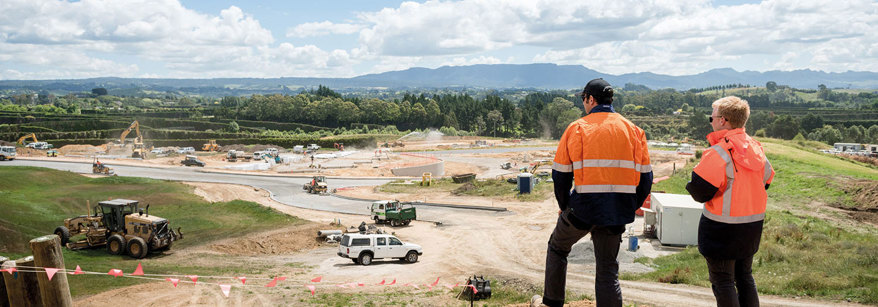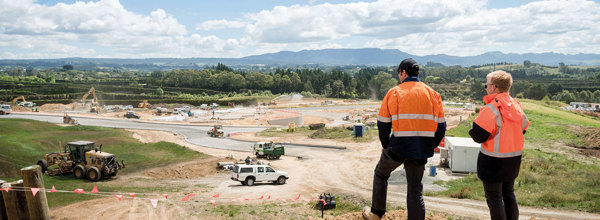If you’re in Bay of Plenty and planning to carry out earthworks it’s important you understand the rules and protections you may need to put in place to minimise any impact to the environment. This includes small scale earthworks on private property.
- The issue
- The rules
- Permitted activities
- Resource consent
- Erosion and sediment controls
- Earthworks monitoring
- Guideline and forms
The issue
If not managed properly, earthworks can lead to erosion of exposed surfaces which produces sediment and dust. As more land is developed for new subdivisions, sedimentation and dust is becoming an increasing problem in Bay of Plenty. If the right controls are not put in place the sediment and dust can pollute streams, lakes and harbours, and kill both freshwater and marine vegetation and animals.
The rules
Rules help to manage the adverse effects from earthworks. For Bay of Plenty these rules are set under the Bay of Plenty Regional Natural Resources Plan. Rule 1 of this Plan outlines what is ‘permitted’ so long as a number of conditions are met, factoring in characteristics like land slope, distance to water bodies, volume of earthworks and area of exposed soil.
If the proposed earthworks don’t comply with any aspect of the Bay of Plenty Regional Natural Resources Plan, you will need to apply for resource consent.
Permitted activities
The permitted activity conditions associated with earthworks are focused on avoiding:
- discharging untreated storm water to vegetation or watercourses
- blocking river or stream flows
- causing erosion
- damage to wetlands
- causing a dust nuisance off site, and
- machinery must be kept out of streambeds.
Resource consent
If the proposed works do not meet the permitted activity threshold, resource consent is needed before any works are carried out. An earthworks resource consent looks at the characteristics of the land where the proposed earthworks are to take place and sets conditions to help achieve suitably engineered excavations and fill that meet the rules. Site characteristics include:
- soil type
- dominant slope
- receiving environment
- assimilative capacity of the environment;
- and climatic conditions.
A resource consent also ensures that earthworks are undertaken in a manner that prevents or limits sediment discharge, thereby protecting the freshwater and marine environments. Generally a resource consent will be needed to work in any river, stream, lake or wetland. Depending on the scale of works you may also need a resource consent for works:
- where the exposed area is more than 1 hectare in any 12 month period (dependant on slope)
- where the volume is in excess of 5,000m3 in any 12 month period (dependant on slope)
- near watercourses
- on steep slopes (>35°)
- near coastal areas or on sand dunes; and
- in ephemeral or overland flow paths (ephemeral and overland flow paths convey stormwater during rain events).
Read about the resource consent process.
Erosion and sediment controls
If you are working on a construction site of any kind, it’s crucial that you have suitable erosion and sediment controls in place before you start earthworks. If the works are permitted through a resource consent, these controls will be specified in the erosion and sediment control plan that was agreed upon when the consent was granted.
If works are being conducted as a permitted activity then sediment controls are still required. The controls are stipulated in the Bay of plenty erosion and sediment control guidelines for land disturbing activities.
Different sites will require different types of controls to prevent runoff from entering waterways. Regardless of the type of site, there are effective methods for controlling sediment and erosion, including:
- regular checks and maintenance, especially before and after rain events
- ensuring subcontractors are informed of their responsibilities
- ensuring workers are using containment devices or a wash pit
- only removing controls when the areas they are protecting are stabilised.
Our Erosion and Sediment Control Guidelines for Land Disturbing Activities can be accessed here or in the resources section below. Note the guidelines are in the process of being updated.
Earthworks season
Winter is the wettest time of year which means there is a greater chance of sedimentation occurring from exposed earthworks. To reduce the chance of sediment entering waterways, major earthworks are only able to take place between 16 September and 30 April.
Earthworks outside this period are not permitted for consented sites unless a winter earthworks variation is obtained. Work is able to continue on permitted activity sites, so long as erosion and sediment controls are installed and permitted activity discharge standards are complied with.
Earthworks monitoring
We monitor earthworks projects to ensure safety and compliance. Some of these conditions require protection measures to be set up before you start your earthworks.
Guideline and forms
The Erosion and Sediment Control Guidelines for Land Disturbing Activities is a guide for anyone wanting to carry out earthworks in Bay of Plenty. It outlines the potential environmental effects from disturbing the land and sets out best practice erosion and sediment control methods to protect the environment.
We’re in the process of updating this guide.
Forms (As-Built Certification)


